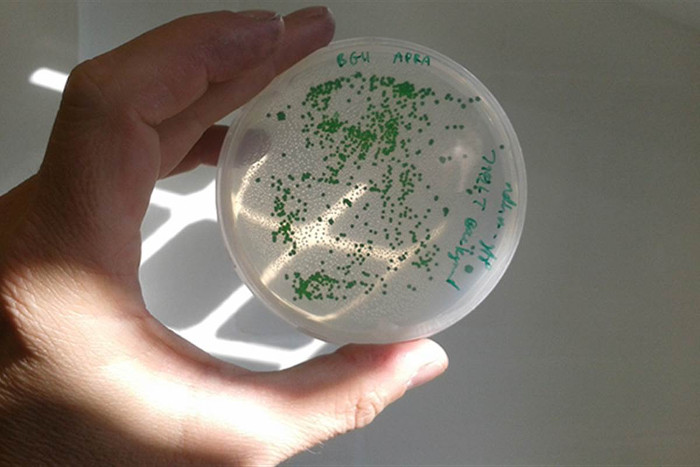Bacteria can see things like people
In a recent surprise discovery, scientists realized that some types of bacteria could see the world in a way similar to humans.
British and German researchers have discovered this by accident during the study of aquatic cyanobacteria . These bacteria often form green patches on stones and gravel.
Scientists have long since realized that bacteria can sense the location of a light source and move toward it. This phenomenon is called phototaxis. However, until now, they still could not understand how bacteria could do that.

Cyanobacteria, a type of bacteria capable of vision.
"We found this very casually. While lighting a region on glass plates to focus on the light-directional properties of cyanobacteria, we suddenly noticed in the cell body of the microbes. This bacterium has a very special bright spot.
The entire body of bacterial cells acts like an eyeball. When that particular bright spot is headed to any direction, their bodies swim towards it. ' Conrad Mullineaux microbiologist from Queen Mary University in London, UK.
This cyanobacteria has the scientific name Synechocystis. They are found in many freshwater rivers and lakes. Their entire cell organ works similarly to a lens.
When light hits the spherical surface of the cell, it will refract and focus on a point on the other side of the cell. This will cause the cell to move in the opposite direction from the light point, which is towards the light emitted. Cells move using tiny tentacles called pili to push the entire cell forward.
If so, these bacteria are the smallest eyeballs in the world with a size of only about 3 micrometers (0.003 mm) in diameter.
"Our observations show that these bacteria fully possess the properties of an optical object (optical object), " Mullineaux said. "This is a major shortcoming in the field of science because we have been studying bacteria under a microscope for more than 340 years."

These bacteria fully possess the properties of an optical object.
This shocking finding shows that bacteria can have the same vision as humans because they also use lens mechanisms like human eyeballs.
According to the researchers, a Synechocystis cell is about half a billion times smaller than the human eye. Besides, the simple structure of bacterial cells makes the world-view images they see will have very low resolution. This means they can only see the scene dimly with basic lines.
"The physical principles of the light sensor activity of bacteria and eyesight in animals are similar. However, they have different biological structures , " said Professor Annegret Wilde from the University of Freiburg. Germany explained.
Brightness is very important for bacteria, especially cyanobacteria. Without the ability to touch and move toward the bright area, these organisms will not be able to perform photosynthesis and survival.
The lamella has existed on this Earth from 2.7 billion VND and has never changed its shape. They are much older than any animal and therefore they are the first animals on Earth to be able to see things around them.
- World of bacteria - interesting things
- Check out the types of polar bacteria that are beneficial to humans
- The ten dirtiest things you contact every day
- Things you don't know about Bifidus bacteria
- When do HP bacteria cause stomach cancer?
- The most toxic and strange forms of bacteria on the planet
- Bacteria predict environmental changes
- Bacteria determine people's lifespan?
- H. pylori ulcer bacteria can prevent diarrhea
- Forget sharks, these 5 bacteria also make you
- Bacteria, an inevitable part of ... humanity
- When bacteria become 'allies' help people clean the air
 Why do potatoes have eyes?
Why do potatoes have eyes? 'Tragedy' the world's largest carnivorous life: Death becomes ... public toilet
'Tragedy' the world's largest carnivorous life: Death becomes ... public toilet Tomatoes were once considered 'poisonous' for 200 years
Tomatoes were once considered 'poisonous' for 200 years Detecting microscopic parasites on human face
Detecting microscopic parasites on human face